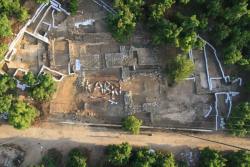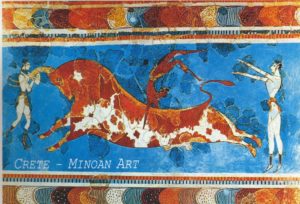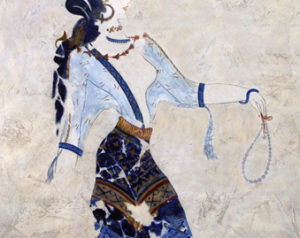Last of the Minoans
 Tel Kabri is located in the western Galilee region of Israel. It is a Canaanite site and features rare finds from the Middle Bronze Age i.e., 2100 – 1500 BCE. Recently, archaeologists found the remains of a palace and a Minoan style fresco in the palace. But what were Minoans doing in Israel some 3,500 years ago? Can it be that modern day Jews, descendants of the Biblical Israelites, are also the last of the ancient Aegeans – the Minoans and the Mycenaeans of Greece? Sounds crazy because we think of the Middle East and the Aegean (including modern day Greece) as two different worlds – studied by two different departments in universities. But once you realize that in ancient times the cultures of the Aegean and the Middle East overlapped, many mysteries are solved.
Tel Kabri is located in the western Galilee region of Israel. It is a Canaanite site and features rare finds from the Middle Bronze Age i.e., 2100 – 1500 BCE. Recently, archaeologists found the remains of a palace and a Minoan style fresco in the palace. But what were Minoans doing in Israel some 3,500 years ago? Can it be that modern day Jews, descendants of the Biblical Israelites, are also the last of the ancient Aegeans – the Minoans and the Mycenaeans of Greece? Sounds crazy because we think of the Middle East and the Aegean (including modern day Greece) as two different worlds – studied by two different departments in universities. But once you realize that in ancient times the cultures of the Aegean and the Middle East overlapped, many mysteries are solved.
It may surprise people but the island of Crete, the center of Minoan civilization, is mentioned many times in the Bible. In scripture, Crete is called “Caphtor” as in Genesis 10:13-14, where a connection is made between Caphtor and the Philistines.
Speaking of the Philistines, it is widely acknowledged that they came from the Aegean and settled on the coast of modern day Israel and Gaza. The Book of Exodus refers to “the way of the Philistines” (Exodus 13:17) i.e., the coastline between Egypt and Israel. According to scholars, the Philistines arrived in the area around 1200 BCE. From this perspective, the Biblical Exodus must have happened around that time, or else the Bible would not be mentioning the Philistines. But I believe that the archaeological evidence points to an earlier date for the Exodus – around 1500 BCE. Meaning, the Philistines must have arrived on the scene 300 years earlier than we thought. How can that be? Well, at the beginning, the “Philistines” may not have been a specific people. The term may have been a generic name for Aegeans. The people that the Bible calls Philistines may have arrived in 1200 BCE, but their predecessors, the Minoans, may have been in the Middle East since long before. In fact, the latest archaeology suggests that there was an Aegean presence in Israel as early as 1600 BCE! Besides the recent findings at Tel Kabri, Minoan wall paintings have been found all along the coast from the Egyptian Delta to Qatna in Syria, to Alalakh in Turkey. Meaning, there were Minoans in the area and they seem to have had a “road” or “way” that ran along the coast. This is perfect synchronicity between the Biblical text and the Minoan archaeology.
Once we realize that we can look in the Aegean for Biblical archaeology, previously unnoticed evidence for the Biblical narrative suddenly comes to light. For example, a Minoan wall painting was found in Santorini that depicts a magical city on a kind of man made island in the Nile. This image perfectly fits with ancient Avaris – the city of the Ivri i.e., the Hebrews – discovered in the Egyptian Delta and dating to the time of the Exodus.
The evidence keeps mounting and it throws new light on the Book of Exodus. For example, when the Bible says that a “mixed multitude” (Exodus 12:38) followed Moses out of Egypt into the desert and eventually into Canaan, we now realize based on the new findings that some of this “multitude” must have been Aegean, specifically Minoans.
Right after the Exodus, the Mycenaeans show up in the Aegean. Who are these people? They call themselves “Danoi”. Many years ago, the legendary Israeli archaeologist Yigael Yadin suggested a connection between the Danoi and the Israelite tribe of Dan. Both were sea-farers (see “The Song of Deborah”, Judges 5:17), both lived along the coast of the Mediterranean and the only place other than Mycenae that Aegean shaft graves have been found is Tel Dan in northern Israel. In other words, Minoans might have joined the Israelites on the Biblical Exodus while Danites might have settled Greece right after that same event. The “Danoi” and the “Danites” may have been intimately related and we hadn’t made that connection until now.
Once you realize the intimate contact between the Aegean and the Middle East at the time of the Biblical Exodus, you also realize that the great competitors to the Israelites in terms of religion were not the Egyptians but the Aegeans. For example, the golden calf may have been part of a “bull jumping” ceremony depicted on Minoan wall paintings. As another example, the Egyptians wore “holy fringes” that had a red thread among them, representing the blood of the goddess Isis. In contrast, the Minoans wore blue fringes – just as the Torah commands (Numbers 15:37-41) and religious Jews wear to this day!


Our Aegean past seems to have been hiding in plain sight. It may be that the Danites and the Danoi, the Philistines and the Minoans, the mixed multitude and the Israelites inhabited the same Bronze Age world. And when we examine that world, we notice that the Danoi of Greece come across through time as the most Israelite of the pagans, and the Danites of Israel come across as the most pagan of the Israelites.
In the Book of Maccabees, it states that the Spartans of Greece were related to the Jews (1 Maccabees 12:1-23). Ancient Sparta is no more, but Jerusalem stands. Can it be that the last of the Minoans and the Mycenaeans are the Jews of today? Do they still carry ancient Aegean traditions embedded in the Torah? Can Israel reclaim the memory of its Danite past?
Click here to see my recent article “Destruction Layer Confirms Biblical Conquest” on The Times of Israel

